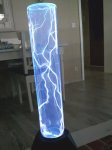I was about to post my results from implementing the LeastSquares function in a COM visible .net dll when I saw your post. So, I grabbed the VB6 code you linked and implemented that in C# as well. Both results match what I get in Spectrum Studio.
Do they match what is output from Excel ?





